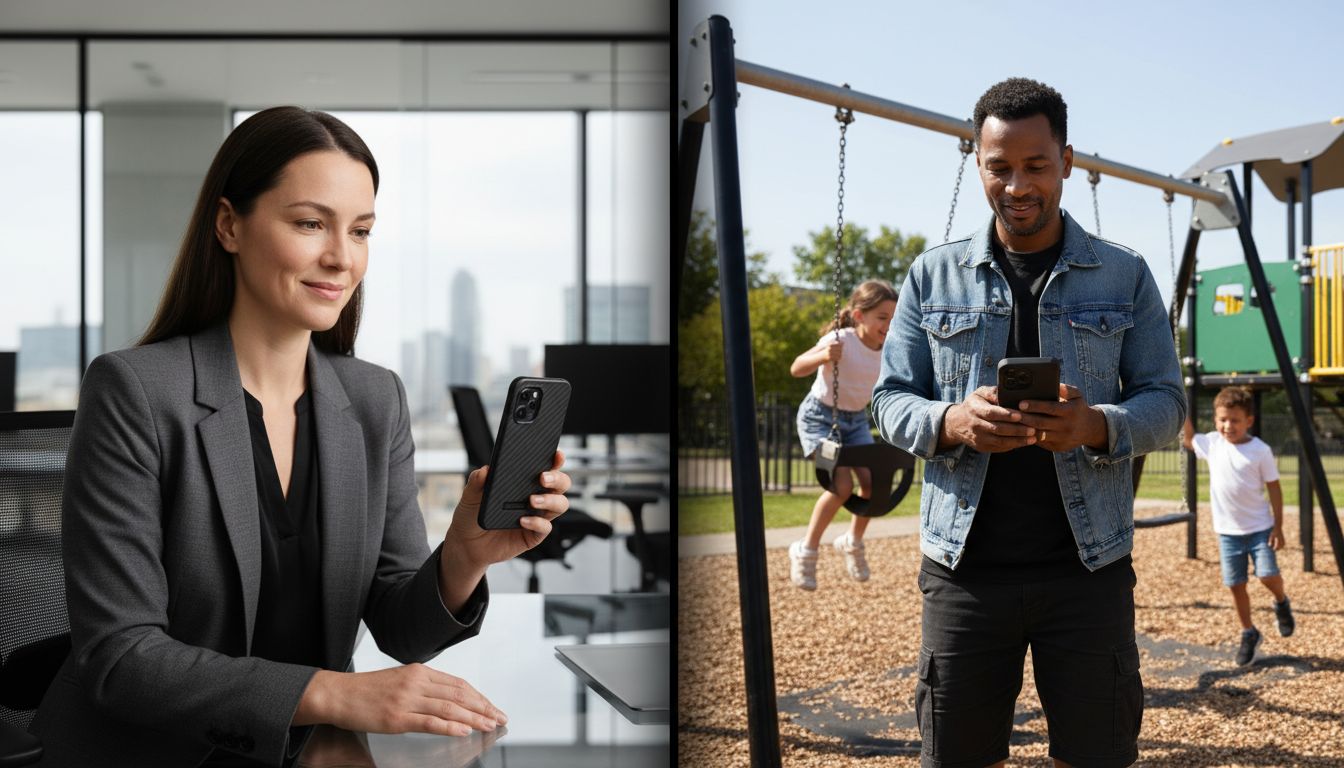
Phone Case Protection: Complete Guide for UK Parents
Share
Did you know that over 85 percent of smartphone users have experienced accidental drops or damage at least once? For parents, a damaged phone can mean sudden repair costs and lost access to crucial information. Choosing the right phone case can make all the difference in keeping devices safe from everyday accidents, unexpected spills, or rowdy playdates. Discover how the right protection features can help you avoid common pitfalls and keep your family’s devices secure for the long haul.
Table of Contents
- Defining Phone Case Protection Essentials
- Types of Phone Cases And Their Benefits
- Key Features For Effective Device Protection
- Real-Life Scenarios: Protecting Your Device
- Common Pitfalls When Choosing A Case
Key Takeaways
| Point | Details |
|---|---|
| Comprehensive Protection | Phone cases should provide impact absorption, screen protection, material durability, and moisture resistance for effective device safeguarding. |
| Case Types and Benefits | Different case types, such as rugged, slim, wallet, battery, and eco-friendly, offer varied levels of protection to suit different lifestyles and needs. |
| Attention to Details | When selecting a case, prioritize functionality, material compatibility, and device specifics to avoid common pitfalls that compromise protection. |
| Holistic Approach | Effective device security extends beyond physical cases to include digital protection measures like tracking and data management, ensuring optimal safety. |
Defining Phone Case Protection Essentials
Protecting your mobile device isn’t just about preventing scratches. Phone case protection represents a comprehensive shield designed to safeguard your smartphone from multiple types of potential damage. According to the Mobile device security guide from the UK Government, physical protection is a critical component of device security and longevity.
Effective phone case protection involves several key elements that work together to defend your device. These typically include:
- Impact absorption: Materials that cushion against drops and bumps
- Screen protection: Raised edges or built-in screen guards
- Material durability: High-strength polymers and reinforced corners
- Moisture resistance: Preventing liquid damage
While many parents focus solely on aesthetic designs, choosing durable phone case features goes far beyond appearances. Research from UK government publications emphasizes that proactive device protection can significantly reduce potential repair or replacement costs. This means selecting a case isn’t just about style – it’s a strategic investment in your device’s longevity and functionality.
Understanding these protection essentials helps parents make informed decisions. A quality phone case acts as a first line of defence, absorbing everyday impacts and preventing potentially costly damage to expensive mobile devices.
Types of Phone Cases and Their Benefits
Choosing the right phone case is more than a simple style decision - it’s about protecting your valuable device. According to research on the best phone cases, parents have multiple options tailored to different protection needs and lifestyles.
Phone cases generally fall into several key categories:
Here’s a quick comparison of common phone case types and their main benefits:
| Case Type | Key Benefits | Typical Drawbacks |
|---|---|---|
| Rugged | Maximum impact resistance Durable materials |
Bulky Heavier design |
| Slim | Lightweight Sleek look |
Minimal drop protection |
| Wallet | Storage for cards Multi-function |
Increased thickness |
| Battery | Extra charging capability | Adds weight Bulky |
| Eco-Friendly | Sustainable materials | Limited style variety |
- Rugged Cases: Maximum protection for active families
- Slim Cases: Minimal design for everyday use
- Wallet Cases: Combines device protection with personal storage
- Battery Cases: Provides additional charging capabilities
- Eco-Friendly Cases: Sustainable materials with protection
The UK Government’s Mobile device security guide emphasizes that selecting an appropriate case isn’t just about aesthetics, but about enhancing device durability and security. For instance, rugged cases like the Otterbox Defender offer robust protection against drops and impacts, while minimalist cases provide sleek protection for less demanding environments.
Understanding these varied case types helps parents make informed decisions. Whether you need hardcore protection for outdoor adventures or a slim case for office use, there’s a phone case designed to meet your specific lifestyle and protection requirements.

Key Features for Effective Device Protection
Protecting your mobile device goes far beyond just selecting a sturdy case. According to the UK Government’s Mobile device security guide, comprehensive device protection involves multiple strategic features that safeguard both the physical hardware and digital data.
Key protection features parents should consider include:
- Impact Resistance: Multilayered protection against drops and bumps
- Material Durability: High-grade polymers that withstand daily wear
- Raised Edge Design: Extra protection for vulnerable screen and camera areas
- Moisture Resistance: Preventing liquid damage in unpredictable environments
- Grip Enhancement: Reducing accidental drops through textured surfaces
Moreover, research on mobile phone security emphasizes the importance of additional digital security measures. This means looking beyond physical protection to include features like remote device tracking, secure authentication methods, and the ability to quickly wipe data if the phone is lost or stolen.
Ultimately, effective device protection is a holistic approach.
By combining robust physical case features with smart digital security strategies, parents can ensure their mobile devices remain safe, functional, and secure in even the most challenging family environments.
Real-Life Scenarios: Protecting Your Device
Parents know that mobile devices are more than just communication tools - they’re lifelines to safety, information, and connectivity. According to government research on mobile phone security, understanding real-world protection strategies is crucial for preventing device loss and damage.
Common high-risk scenarios for device damage include:
- Active Family Settings: Sports events, playground adventures
- Kitchen and Cooking Areas: Potential liquid and heat exposure
- Work and Study Environments: Risk of accidental drops and bumps
- Travel and Commuting: Crowded spaces with potential theft risks
- Child-Related Zones: Unpredictable handling and potential drops
The online advice service for mobile protection recommends practical steps like enabling tracking features, using remote locking capabilities, and maintaining regular data backups. This proactive approach transforms your phone case from a simple accessory into a comprehensive security system.
Ultimately, device protection is about anticipating potential risks and creating multiple layers of defence. By understanding these real-life scenarios and implementing smart protection strategies, parents can significantly reduce the likelihood of costly device damage or loss.
Common Pitfalls When Choosing a Case
Selecting the perfect phone case isn’t as straightforward as it might seem. Research from the best phone cases guide reveals several critical mistakes parents frequently make when protecting their mobile devices.
Common case selection pitfalls include:
- Overlooking Functionality: Cases that block essential ports or buttons
- Prioritizing Aesthetics: Choosing style over actual protection
- Ignoring Device Specifics: One-size-fits-all approach to case selection
- Compromising Signal Quality: Bulky cases that interfere with reception
- Neglecting Material Compatibility: Cases that don’t match device specifications
According to the UK Government’s mobile device security guide, device protection should balance comprehensive safety with practical usability. Ultra-thin cases like the Totallee might look sleek, but they offer minimal protection, while overly robust cases like the Otterbox Defender can be excessively bulky and inconvenient.
The key is finding a case that provides robust protection without compromising your device’s core functionality. Parents should carefully evaluate their specific needs, considering factors like daily usage, potential environmental risks, and the unique characteristics of their mobile device.
Protect What Matters Most with StudioShake Phone Cases
Parents face the constant challenge of safeguarding their family’s devices from drops, scratches and everyday accidents. With concerns about impact absorption, material durability and screen protection all at the forefront, finding a reliable phone case that balances strong physical defence with user-friendly design is essential. Your phone deserves more than just style it needs comprehensive protection that stands up to busy family life.
Explore our £1 Case Collection – StudioShake for budget-friendly options or dive deeper into our full StudioShake range designed for robust device defence.

Don’t wait until a costly drop happens. Visit StudioShake today to discover phone cases engineered to defend against impact, moisture and more. Enjoy peace of mind knowing your device is covered with practical, durable protection tailored to your lifestyle. Shop now to give your mobile the shield it needs.
Frequently Asked Questions
What features should I look for in a durable phone case?
When choosing a durable phone case, consider features such as impact resistance, material durability, raised edge design, moisture resistance, and grip enhancement to ensure maximum protection for your device.
How do different types of phone cases compare in terms of protection?
Rugged cases offer maximum impact resistance but can be bulky, while slim cases are lightweight but provide minimal drop protection. Wallet cases add storage options, battery cases offer extra charging, and eco-friendly cases use sustainable materials with varying protection levels.
Are there any common mistakes to avoid when selecting a phone case?
Yes, common mistakes include overlooking functionality that blocks essential ports, prioritizing aesthetics over protection, ignoring device-specific compatibility, compromising signal quality, and neglecting material compatibility for your device.
How can I protect my phone from potential damage in everyday situations?
To protect your phone from everyday damage, consider using a case suited for high-risk scenarios like active family settings or travel, enable device tracking features, regularly back up data, and understand the potential risks associated with your environment.
